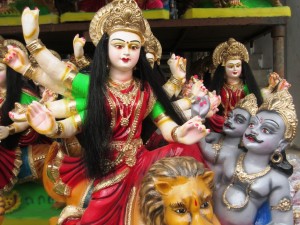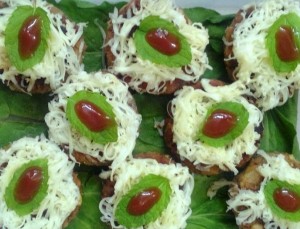Navratri literally means nine nights and each night is dedicated to one of the nine avatars of Maa Durga. People in different state celebrate Navratri with different traditions and customs with common purpose to get blessings from mother Goddess. It is festival of fasting and chanting mantras for North Indians while DurgaPuja for Bengalis and worship in form of Garba (Folk dance) for Gujaratis. The celebration of Navratri starts with the kalasha Sthapana on first day and ends on Maha Navavi (ninth day), followed Vijiya Dushami or Dussehra. It is believed that, worshiping Maa Durga for nine days and nights with fasting and chanting mantras, will invoke the blessing of Maya to overcome all obstacles and showers prosperity, happiness and spirituality.
According to Hindu calendar, Navratri is celebrated for three times a year. However, most people celebrate Navratri twice a year. The Vasant Navratri (Febuary-March) celebrated in North and Western India and Sharad Navratri (September – October) is celebrated in all parts of India. As we worship different powers of Maa Durga, each day and night has its own significance thus nine days and nights of Navratri are also divided in to three sets, according to powers of Maa Durga. The first three days, Maa Durga worshiped as a spiritual force which destroys all impurities and evils within us and the second set, next three days, Maa Durga worshiped as wealth giver. During final three days, Maa Durga worshiped as goddess of knowledge who gives rewards to her devotees for their deeds.
Nav-Durga and 9 Colours of Navratri 2014
People worship the many forms of Maa Durga but main three avatars are Saraswati, Laxmi and Mahakali and each giving rise to 3 more forms together known as “Nav-Durga”. Since each night is dedicated to one of the nine avatars of Maa Durga, each night has its own importance. As Colours play an important role and each avatar represents particular colour, during Puja observers offer sari of a particular color to Maa Durga and wear a particular color as well.
This year, Sharad Navratri is starting from 25th September 2014 and ends on 3rd October 2014. Description of each avatar of Nav-Durga and the whole schedule for Navratri page 2014 with Navratri colors is given below.
- Day 1 – 25th September 2014 – Maa Shailputri: A Daughter of king of mountain (Himalaya). Maa Durga worshipped as girl child. The Navratri puja starts with Kalasha Sthapana and Yellow is the colour for first day of Navratri puja 2014.
- Day 2 – 26th September 2014 – Maa Bhrahmcharini: Maa Durga worshiped as a young woman with love and loyalty. Green is the colour of the second day.
- Day 3 – 27th September 2014 – Maa Chandragatha: A Matured woman with ten hands and three eyes and eight out of ten hands caries weapons, but remaining two signals for giving blessing and stopping harm. The colour for the third day is Gray.
- Day 4 – 28th September 2014 – Maa Kushmanda: The forth avatar of Maa Durga with eight arms holding weapons and a mala who gives blessing for basic necessities to her worshipers. Orange is the colour for fourth day of Navratri 2014.
- Day 5 – 29th September 2014 – Maa Skandamata: She holds her son in her lap and gives blessing to her worshipers to get rewarded as per their deeds. White colour is the colour for fifth day of Navratri 2014.
- Day 6 – 30th September 2014 – Maa Kaatyayani: she named as “Kaatyayani” because she stayed in ashram of Kaatyayan for self-punishment. Red is the colour for the Sixth day of Navratri 2014.
- Day 7 – 1st October 2014 – Maa Kaalratri: The seventh avatar of Maa Durga, popularly known as “Kaali”, is destroyer of darkness and ignorance. Blue is the colour for seventh day of Navratri 2014.
- Day 8 – 2nd October 2014 – Maa MahaGauri: She is a symbol of peace and kindness. Pink is the color for the eighth day of Navratri 2014.
- Day 9 – 3rd October 2014 – Maa Siddhidatri: The Ninth avatar of Maa Durga is also worshiped by saints and gods because she has all powers to bless her worshipers for 26 different wishes to fulfil. Purple is the colour for final day of Navratri 2014.
Note: This Year’s Navratri celebrations are only Eight days because Day 8 & 9, are both falls on the same date 2nd October 2014. However, people in Gujarat will play Garba on day 9 as well.
To see Hindu Calendar (CLICK HERE)
Navratri Puja Vidhi
The best time to perform Navratri Puja is an early morning, just at the time of sunrise. During Navratri, people get up early and wear clean clothes after taking bath and some devotees also follow Navratri colors hence they wear a particular color as well.
The “Akhand Jyot” needs to be taken care because once you light it, it should remain as it is for nine days and nights and rest Puja will be same as Hindus practice daily.
The Eighth day of Navratri is the birthday of the Mother Goddess, hence observers worship their call-Devi and offer Bhogas as well.
The Ninth day of Navratri is known as MahaNavami and people from different states celebrate it with different rituals. People in North India do “Kanya Puja” and invite nine young girls and offer them delicious food and gifts while Bengali people do arrange MahaAarti and then after last night they do vishrjan of Idol of Maa Durga in sea.
Navratri Puja Materials
- Diya (Lamp) which burns throughout Navratri days, is also called as “Akhand Jyot”.
- Coconut
- Kalasha (Pitcher)
- Five Suparis (Betel Nuts)
- Water
- Rice
- A coin
- Shringar items for Maa Durga
Navratri Fasting
It is not compulsory for observers to fast for all nine nights. However, strict observers do fast for nine days and nights, with others do it on the first day and the last day of Navratri only. It is believed that, person who fasts in Navratri, overcomes all obstacles and achieves prosperity, happiness and spirituality. Devotee offers particular Bhogas (Food) to Maa Durga during Puja. Once devotee finishes Aarti, he or she can take food which is meant for Navratri. However, only very strict devotee follows all rituals and takes fruits and milk only, others consume a variety of food that meant for fast. Nowadays, people also practices “Ekana” that means eat once a day.
During Navratri, people also stop smoking, drinking alcohol and eating non-veg food and some people do not eat food that prepared using Onions and garlic as well.
Bhogas
The Bhoga means kind of food that offer to Maa Durga or any God, during Puja or Aarti. In Navratri, people offer particular Bhogas to particular avatar of Maa Durga, are listed below.
- Maa Shailputri: Ghee (Purified Butter)
- Maa Brahmcharini: Sugar
- Maa Chandragatha: Milk or sweets prepared from Milk specially Kheer
- Maa Kushmanda: Malpua
- Maa SkandaMata: Banana
- Maa Kaatyayani: Honey
- Maa Kalratri: Jaggery (Gud or Gur)
- Maa MahaGauri: Coconut
- Maa Siddhidatri: Sesame Seeds (Tal or Til)
Food dishes for Navratri Fasting
The fasting is practiced only by devotees in Northern and Western India, but South Indians do not fast and prepare different Sundals and sweets and offer it to Maa Durga. As per Hindu rituals, some very popular food dishes for fasting are listed below.
- Sabudana Vada
- Sabudana Khichadi
- Sabudana Papdi
- Dahi Pudine Vale Aloo
- Dahi Lassi
- Fruits
- Banana and Aloo chips as well as Raita
- All Sweets that contains Milk and Sugar only
- Dry fruits
- Shigare ke pakode
Navratri Celebrations
Navratri is a very important festival in Hinduism and different states of India, celebrate Navratri with different rituals, traditions and customs. The main two, very popular celebrations are Durgapuja of West Bengal and Garba (Folk Dance) of Gujarat.
 Durgapuja
Durgapuja
The state of West Bengal celebrates Navratri in the form of Durgapuja. It is the biggest festival for Bengali people and they celebrates it by installing idol of Maa Durga at various places, pandals, colonies or even in houses. The capital city of the West Bengal, Kolkata, is the best place to celebrate Durgapuja and if you want to be a part of Durgapuja 2014, CLICK HERE for travel advice and information about Kolkata.
 Garba
Garba
The hypnotic, rhythmic circular dance is called Garba. Gujarat is the only place where Navratri is celebrated for nine days and nights, with such passion and jubilation that cannot be matched. During Navratri, Gujarat immersed in worship of Maa Durga and from cities to towns & villages and from streets to poles, you will find many places to celebrate Navratri.
Come to Gujarat this Navratri and be a part of the unique way of worship.
For further in information about Garba and Navratri Celebrations in Gujarat.
Please Check my next Article “Colours of Gujarat’s Navratri– it will publish soon.
Let’s be part of this year’s grand celebrations of Navratri. My Maa Durga will bless you all to attain prosperity, happiness and spirituality.
“Jai Matadi” “Jai Maa Durga” “Jai Maa Ambe”












